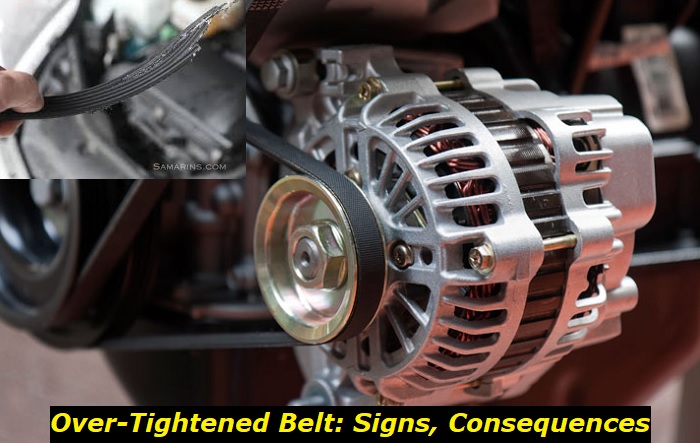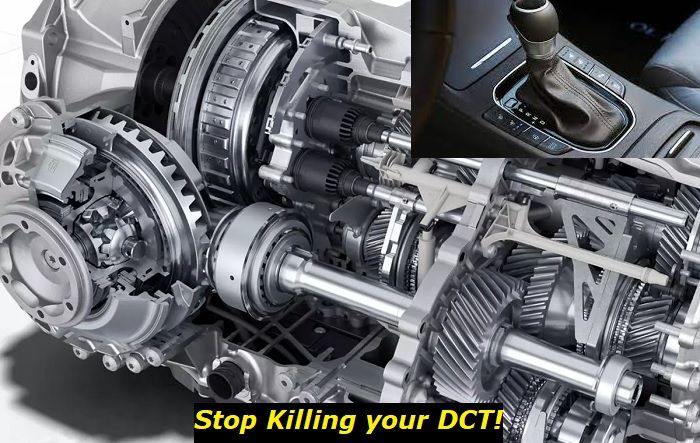Over-tightened belts in your vehicles can be damaged or broken themselves, they can damage pulleys and bearings, and they can affect the work of the entire engine. You shouldn't ignore any signs of an over-tightened belt in your vehicle and immediately address the issue. Also, you shouldn't apply any DIY repair methods when it comes to belt tension.
Engine belt issues highlights
- Level of importance:High
- Commonreasons:Age, mileage, internal engine problems
- DIY inspection:Possible
- DIY repair:Impossible
- Price for repair:$250 - $550
- Can you drive?Not for long
- Ways to fix:Replacement of affected parts

Serpentine belt tension problems
In older cars, serpentine belts were tensioned by the alternator. Later on, when cars got hydraulic power steering, ACs, and lots of other equipment connected to the serpentine belt, these belts got their own tensioners. It means that the tensioner is responsible for providing the serpentine belt with the proper tension.
So, in the majority of modern vehicles, it's almost impossible to over-tighten the belt. Because you don't physically tighten it - you just install all the units and they work automatically to tighten the belt with the tensioner and provide it with optimal working conditions.
But here are some ways to over-tighten the serpentine belt:
- in older cars, you tighten this belt manually by moving the alternator, so it's not that hard to tighten it too much;
- if you install something incorrectly, this may have an impact on the tightening of the belt;
- improper type of tensioner or just malfunctioning tensioner may easily overtighten the belt without you knowing this;
- the wrong type or size of the belt can also be the reason why the tightening is incorrect.
So, you still have quite a lot of chances to over-tighten the serpentine belt even if you have a modern vehicle. It's not always your fault - sometimes you may install the wrong belt or tensioner because someone sold it to you assuring you that they are exactly for your vehicle. But the consequences are still pretty bad.
Symptoms of over-tightened serpentine belt
Unfortunately, your car will not show you any certain signs that the alternator belt is overtightened and all of the signs mentioned below are just possible, in this situation. You may not find any changes in the way your car works until one of the pulleys is broken.
But still, let's have a look at some possible symptoms:
- bearings and pulleys will make some unpleasant noise - it may be whining or humming noises from the drive belt;
- also, the belt itself may make some whining or whistling noises when overtightened badly;
- the bearings and pulleys will be hot, so if you touch them right after you turn off the engine, you will feel the excessive heat;
- you can barely move the belt with your finger if you press on it from above - this means the belt is surely over-tightened.
Well, these symptoms are sometimes hard to notice because whining noises may be too quiet and the engine work sound will not allow you to hear them at all. And it may be that you will get to know about the over-tightened serpentine belt when it is broken.
What are the consequences of serpentine belt over-tightening?
I can't tell you that the over-tightened drive belt is the worst thing you can experience in your vehicle. But obviously, it can lead to some extremely unpleasant things. First of all, consider these effects:
- worn-out and broken pulleys;
- destroyed bearings;
- broken drive belt;
- you may get stranded on the roadside.
When the drive belt brakes, your AC, power steering (if it's hydraulic), and alternator stop working. It means that driving your car further will be more than just hard. In some cases, you will not be able to drive at all.
But the good thing is that the broken drive belt will not destroy your engine. You will have to replace all broken parts and the car will be good to go further.
Over-tightened timing belt problems
Over-tightening the timing belt is even less possible than having these problems with the drive belt. But it's not impossible. You can buy the wrong belt or just choose the cheap aftermarket belt that is 2 mm shorter than needed. You can get the wrong tensioner or just install something incorrectly. There are plenty of ways how you or your mechanic can succeed in messing up with your timing belt.
I will focus on the signs and also the consequences of such an issue rather than telling you how to do this.
What are the signs that the timing belt is over-tightened?
In this case, the engine may show you more directly that something is wrong with the timing system:
- the timing itself may be changed - it may affect the work of the engine, it may become harsh, shaking, lose some power;
- the hard start is one more important sign that the timing is slightly changed;
- you can hear some whining noises from inside the engine - they usually come from pulleys and bearings;
- the belt may also whine or hum depending on the type and size of the belt.
Unfortunately, checking this belt is not that easy. It's covered by a plastic or metal cover that is hard to unscrew. Even if you do this, you aren't likely to understand if the belt is tightened too strongly.
What are the consequences of an over-tightened timing belt?
Whenever you suspect that the timing belt is improperly tightened, you should immediately have it checked by professionals. If it breaks, you will not be able to repair the engine just be installing the new belt. In most engines, the valve system will be heavily affected whenever the belt is broken.
The reason for these consequences is that the valves will most likely meet with the cylinders because when the belt is broken it doesn't provide the engine with the proper timing of camshafts and crankshaft rotation. As a result, one or two cylinders will hit the valves heavily and will most likely bend them.
A broken timing belt is one of the very common reasons for engine replacement. Repairing your engine after this issue happens is not always a good idea because of the huge labor costs and high prices for OEM parts.
Also, the pulleys and bearings may overheat and break but this is not the big issue. The only problem is that a stuck pulley on a water pump or on a tensioner may lead to even higher risks of engine failure because of the timing belt breaking.
How to avoid over-tightening belts in your car?
It's always a good idea to maintain your vehicle in a good repair shop that is specialized in a certain brand of cars. It's always even better to let dealerships do the job for you. I know that it will cost you a fortune, but you will be protected from such bad events as an over-tightened belt breaking on the go.
Whenever I've seen such problems, people reported that they had repaired their cars in cheap repair shops or with the help of private mechanics that work illegally in their home garages. This leads to issues like over-tightening because of the lack of expertise and experience on the mechanic's side.
So, here's what you will want to do to avoid problems with over-tightened belts:
- always choose a proper shop for changing or maintaining belts in your vehicle;
- be careful if you want to save some money and find a cheaper mechanic - this is really dangerous;
- buy OEM parts or at least choose reliable and reputable brands that offer high-quality products;
- be careful with any DIY actions when it comes to belts in your car, especially if you don't have the proper experience.
Also, make sure you change the belts and all the belt kits at the proper mileage or according to some time intervals. Otherwise, you may experience problems with belts even without them being over-tightened or installed improperly.
Final thoughts
You should understand that the timing belt is vitally important for your engine. Also, the drive belt may leave you stranded on the side of the road. So, maintaining these units in your engine is extremely important for the proper life of the engine and to avoid premature death.
But if you notice that one of the belts is acting weirdly after it was replaced, you better don't ignore this situation and immediately address the problem by visiting the shop or the dealership. Be careful because the broken timing belt may just kill the engine in your vehicle and make it too expensive to repair the car.
About the authors
The CarAraC research team is composed of seasoned auto mechanics and automotive industry professionals, including individuals with advanced degrees and certifications in their field. Our team members boast prestigious credentials, reflecting their extensive knowledge and skills. These qualifications include: IMI: Institute of the Motor Industry, ASE-Certified Master Automobile Technicians; Coventry University, Graduate of MA in Automotive Journalism; Politecnico di Torino, Italy, MS Automotive Engineering; Ss. Cyril and Methodius University in Skopje, Mechanical University in Skopje; TOC Automotive College; DHA Suffa University, Department of Mechanical Engineering






Add comment